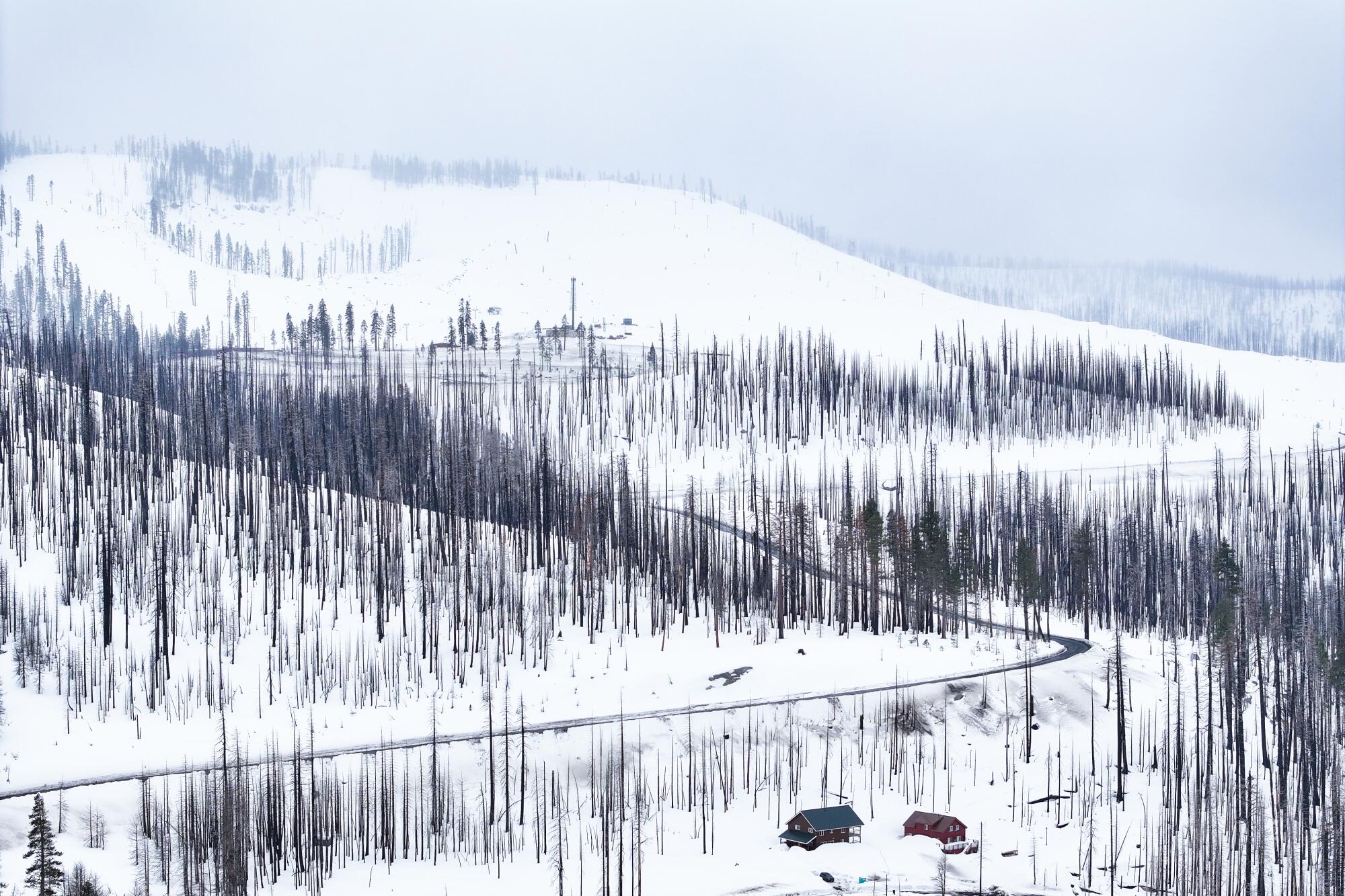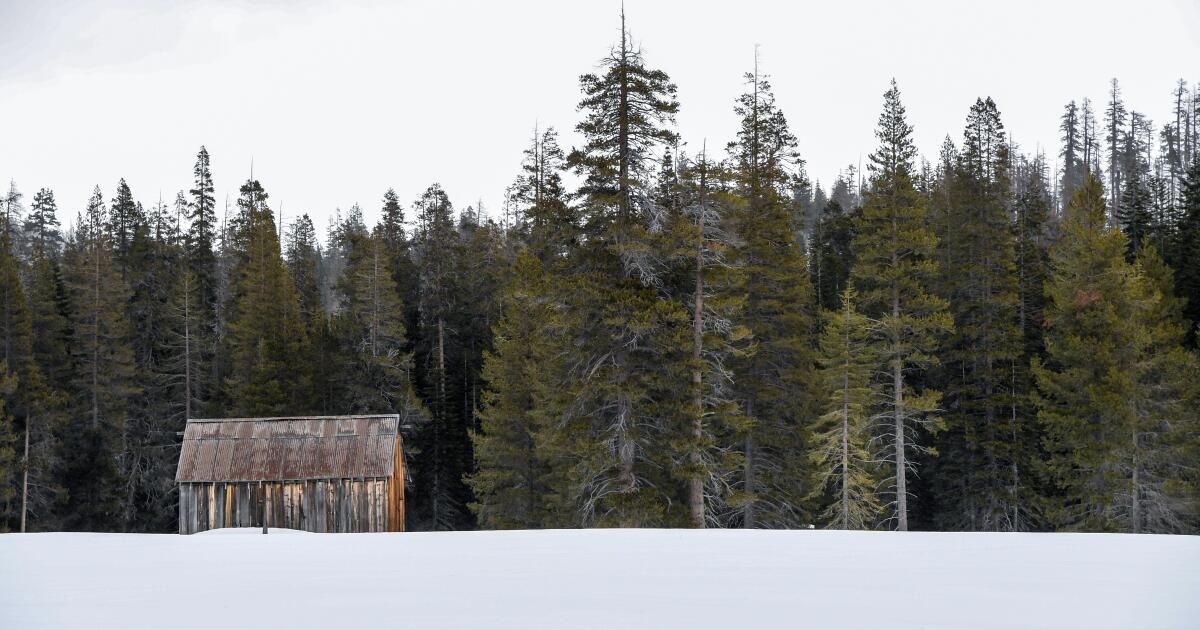Cold, gray storm clouds swirled over Phillips Station near South Lake Tahoe Thursday as state officials trudged through fresh powder to conduct their third snow survey of the season, just hours before a Monster snowstorm will dump up to 12 feet of snow along the Sierra Nevada.
“It's a lot colder than it was a month ago, and that's indicative of the big storm system that's coming that will probably bring a lot of rain and a lot of snow, which is good for our snowpack,” Sabrina Washington said. an information officer for the California Department of Water Resources.
Aggressive and impactful reporting on climate change, the environment, health and science.
Even without the incoming storm, the state's snowpack has shown considerable change since the beginning of the year, when it measured just 28% of normal and sparked concerns that a “snow drought” was developing.
As of Thursday, statewide snowpack measured 80% of normal for the date, with a snow water equivalent of 18.7 inches. Snowpack was about 70% of its average for April 1, the date it is typically deepest.

Members of DWR's snow study and water supply forecasting unit wear snowshoes while making measurements Thursday at Phillips Station in the Sierra Nevada.
(Sara Nevis / California Department of Water Resources)
“We've built very well; we just started late,” said Andy Reising, water resources engineer with DWR's snow survey and supply forecasting unit. “We hope to catch more in the next month.”
In fact, the current rainy season started slowly, with little rainfall in November and December. Many of the storms that hit California in January and February were warmer than usual (bringing more rain than snow) and often fell in southern parts of the state. (February was one of the wettest on record in Los Angeles, with 12.66 inches of rain in downtown Los Angeles)
But officials were optimistic that the impending blizzard could deliver a significant increase in snow.
“The good news is that we will have a big storm here over the weekend, and it will be cold,” Reising said, noting that lots of dust are expected at both high and low elevations across the Sierra. “We are very happy to announce that this will happen and will help us get closer to average, or perhaps above average, for the state.”
The National Weather Service has issued urgent storm warnings warning of the strongest Sierra storm of the season. Up to 12 feet of snow could fall on the highest peaks through Sunday, while areas with an elevation of 5,000 feet or higher could receive 5 to 10 feet.
The NWS has also issued wind advisories and avalanche watches throughout the region.
But while the snowpack has shown some growth, more will be needed to reach 100% of normal for the year, DWR officials said. They will closely monitor weather forecasts and runoff potential in the coming days and weeks.
“We are in the final month of the traditional snow season and, while conditions have improved dramatically since the beginning of the year, March will be critical in determining whether we finish above or below average,” reads a statement from the director. Karla Nemeth. “No matter how the season ends, we are ready to harness the water we have to benefit communities, agriculture and the environment, and continue to store stormwater in our groundwater basins for future use.”

An aerial view of the Sierra Nevada near Phillips Station Prairie, shortly before Thursday's snow survey.
(Fred Greaves / California Department of Water Resources)
The slow start to the year has led to some uncertainty about the future of water supply, as snowpack typically accounts for about a third of California's supply in a given year.
Earlier this month, DWR predicted it could allocate 15% of requested supplies to the State Water Project, which supplies water to 29 agencies serving 27 million people.
But that allocation could increase if the coming snowstorm lives up to its promise, said Molly White, water operations manager for the State Water Project.
“We have seen an improvement in conditions and… we will do calculations to reassess the allocation in March,” he said.
The storm will almost certainly cause a big impact, said Daniel Swain, a climate scientist at UCLA. During a briefing on thursday, noted that the system is somewhat unusual due to its frigid temperatures and humid conditions. It's rare to see such a cold air mass that's also moist and associated with so much storm activity, he said.
“The only part of the state that hasn't been as wet as expected at this point in the season is the Sierra Nevada,” Swain said.
“That's all going to change dramatically in the next 48 hours with feet of snow almost everywhere,” he said. “They will not be measured in inches but in feet in almost all places above 3,000 or 4,000 feet, so this will be an event that will produce heavy or extremely heavy snowfall, even at elevations that have had difficulty so far this season to see significant accumulations. ”
The storm could set records for daily or two-day snow accumulation in some places, he said. Snow may fall at rates of 2 inches per hour, or even up to 5 inches per hour, for several hours at a time, she said, with totals between 50 and 100 inches in some places.
“This will be another snow storm probably for the record books in some places,” Swain said. “And so, when all is said and done, the Sierra snowpack will very likely be significantly above average almost everywhere in just a week.”
However, David Rizzardo, director of the DWR's hydrology section, cautioned that one storm does not constitute a season. He said the latest projections show runoff from melting snow could still be below average this spring and summer due to the “extremely dry and warm fall” that kicked off the water year.
Snow runoff projections help water managers and reservoir operators know how much will be available for use later in the year.
“The good news is that we should see these numbers increase, hopefully much closer to average or even slightly above average, but we still have to have March,” Rizzardo said.
Surface water storage in California's major reservoirs is currently 119% above average, state data shows. The latest seasonal outlook from the National Oceanic and Atmospheric Administration is unclear about what March, April and May could hold for California, with equal chances for wet or dry conditions.
Even as officials celebrated a possible increase in the state's water supply, they also warned of the dangers of the incoming blizzard.
“This upcoming storm will cause significant impacts throughout the Sierra Nevada and will make travel nearly impossible,” said state hydrometeorologist Angelique Fabbiani-Leon. “We want to remind the public: do not travel to the Sierra Nevada this coming weekend.”












